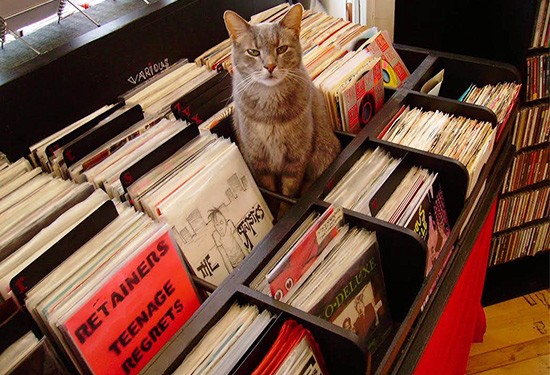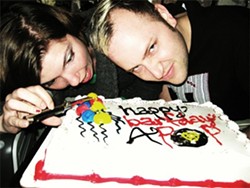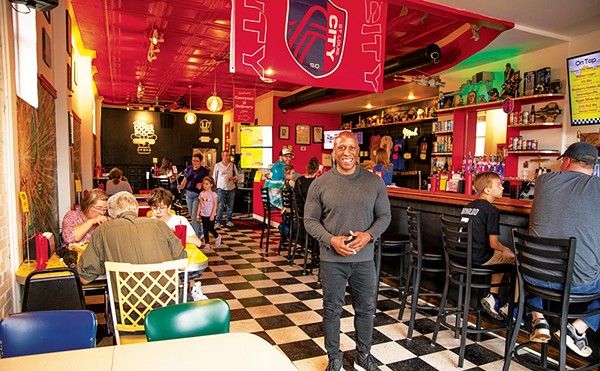By Joseph Hess and Mabel Suen
Patrons of Apop Records found a wide range of intriguing things to peruse and amuse the years, from half-naked no wave bands to Beryl the grouchy-yet-lovable store cat. When Tiffany Minx opened the store in 2004, she planned on running the operation for maybe five years. Now, after a decade of slinging counterculture ephemera, she's ready to move on. The brick-and-mortar storefront on Cherokee Street will offer up its last slabs of wax on Monday, October 27.
See also: Apop Records Celebrates Ten Years at Plush: Photos
Minx and business partner Dustin Newman opened Apop's original location in Columbia. Through merging their own record collections with gems picked up from other enthusiasts, the two offered a selection of niche music along with oddities including rare books and obscure VHS tapes.
The shelves were densely packed with industrial noise, lo-fi electronic, and outsider punk and metal via vinyl, cassette tape, and even handmade CD-Rs. The store stocked mail-order rarities from across the globe -- work from artists including Jandek and Peter Sotos, known for their hyper-reclusive nature, found a home between Apop's walls.
"It was inside of a 600-square-foot little shack. It was a crummy building, but we had a lot of fun there," Minx says. "It was crammed to the gills with stuff. It was like Apop is now, but condensed. It looked like it had been worn over time."
Since both were deeply involved with music, Minx and Newman booked many in-store performances. The shows themselves reflected Apop's early days in a nutshell, attempting to cram too much music into a space that couldn't necessarily accommodate it. Punk and experimental artists would play on top of display cases and occasionally even on the roof of the shop.
"We had a really hot day in Columbia. The air conditioner was broken, and we decided to leave the shitty landlord and just box everything up and move to St. Louis," Minx says. The entire store's stock sat in a local basement for months until the two found the right space for Apop to grow.
Minx credits Sheri Ford, former owner of the now-defunct record store Tension Head, for Apop's move to Cherokee Street. With her suggestions, Minx and Newman checked out spots in the neighborhood before settling on a building at the corner of Cherokee Street and Oregon Avenue in 2006.
"While Dustin was working another job, I was painting. We pulled out shelves from other stores. We were constantly salvaging and building stuff all the time. It was really cold that winter -- it sucked," Minx says of the move.
Apop opened the following spring and gradually built a loyal customer base, and with it, a reputation for carrying stock other record stores might not touch or even know what to do with. Newman relocated to the Pacific Northwest in 2013, leaving the store to Minx. He still operates the Apop record label and runs Web store distribution from his new home in Washington. Following Apop's tenth anniversary, Minx is gearing up to move on as well.
"I am ready to do something new," she says. "I actually tried going to school while doing the store once before, and it was just too overwhelming. I love this place, but I'm not intellectually stimulated by it enough. I need to be constantly challenged, and I don't feel like I can get that just by running a store."
Apop established a long legacy for underground music in St. Louis over the years. Through Record Store Day and its many in-house performances, it was known for its off-the-wall parties and events. We've reached out to past performers, patrons and employees, hoping to squeeze out a little history. The story of Apop Records and its impact on music and art in the Midwest is best told through the words of the people who loved the shop and what it provided.







